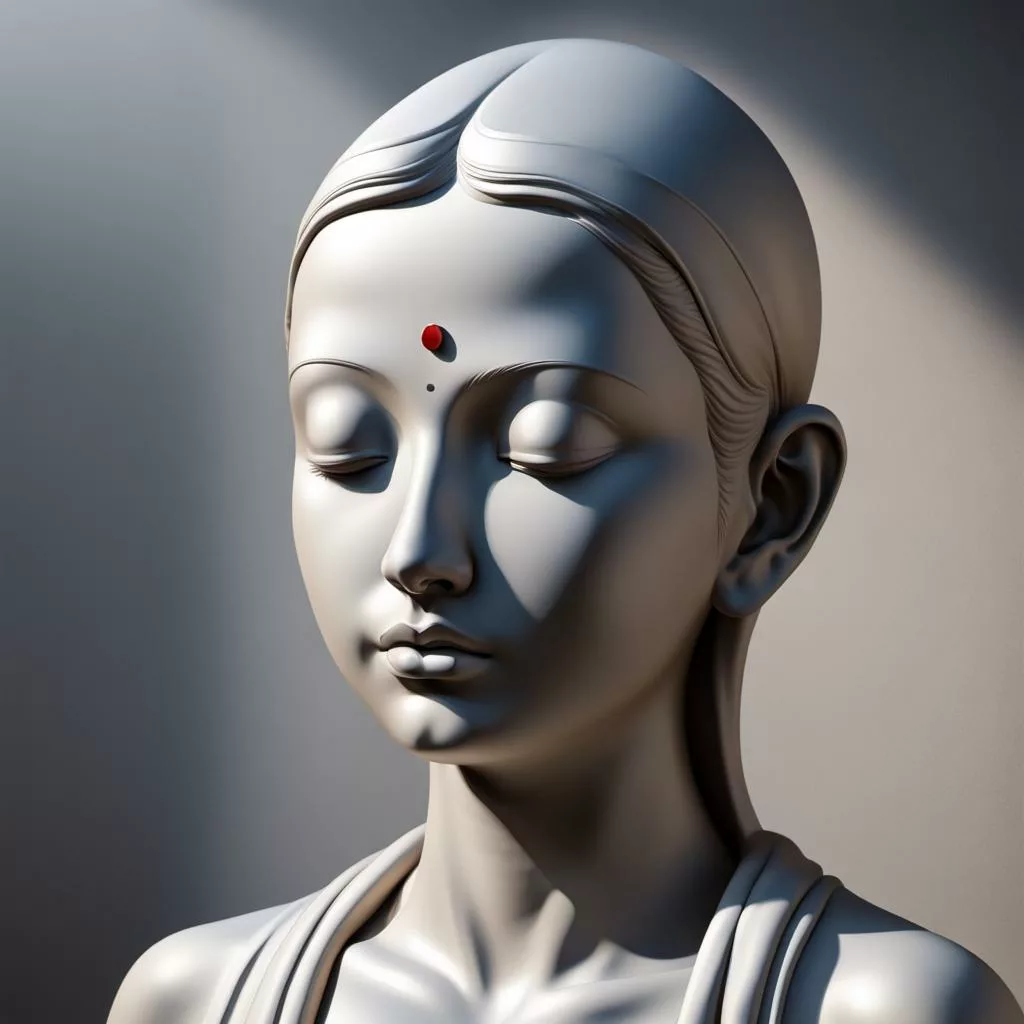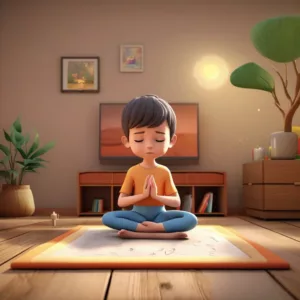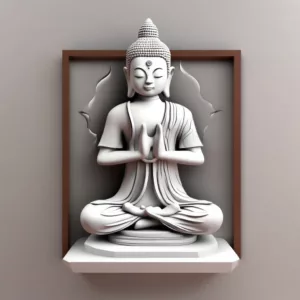What is Meditation?

Meditation definition: stably focusing the mind upon an object. Prior to that occurrence, we are training in meditation – learning how to meditate. The two phases have quite different characteristics.
Table of Contents
Meditation Definition Summary
Summary Table: Meditation Definition
| Concept | Description | Subtypes/Examples | Related Concepts |
|---|---|---|---|
| Meditation meaning (Practice) | Cultivating mental calmness and awareness through focused attention. | * Mindfulness Meditation * Focused Meditation * Guided Meditation * Transcendental Meditation * Loving-Kindness Meditation | Mental States, Meditation definitionTechniques |
| Mental States | Qualities developed through meditation. | * Mindfulness (Non-judgmental Observation of Thoughts & Sensations) * Concentration (Focused Attention on a Single Point) * Relaxation (Physical and Mental Ease) * Inner Peace (Sense of Calmness and Well-being) * Clarity of Thought (Improved Focus and Cognitive Function) * Equanimity (Mental Balance in Face of Challenges) | Meditation Techniques, Benefits |
| Meditation Techniques (Expand on existing ones): | Specific methods for cultivating mental states. | * Focused Breathing * Diaphragmatic Breathing (Focusing breath on the abdomen) * Counting Breaths * Body Scan Meditation (Systematic Observation of Bodily Sensations) * Walking Meditation (Mindful Attention to Walking Movements) * Visualization Meditation (Creating Mental Images for Focus or Relaxation) * Loving-Kindness Meditation (Directing Compassion Towards Oneself and Others) * Mantra Repetition (Chanting Sacred Syllables or Phrases) * Progressive Muscle Relaxation (Tensing and Relaxing Muscle Groups) * Qigong (Mind-Body Practice Combining Movement and Breathwork) | Meditation Meaning and Practice, Mental States |
| Meditation Practice | Elements involved in a meditation session | * Posture (Sitting, Lying, Walking – Each with Variations) * Breathing Techniques (Diaphragmatic Breathing, Counting Breaths) * Guided Audio (Instructions from a Teacher) * Duration (Sessions can Range from Minutes to Hours) * Meditation Timer (Optional Tool for Setting Duration) * Retreats (Intensive Practice Sessions in Quiet Settings) | Mental States, Benefits |
| Benefits of Meditation (Expand on existing ones): | Positive outcomes associated with regular practice. | * Stress Reduction (Physiological and Psychological) * Improved Focus and Concentration * Increased Self-Awareness (Understanding Thoughts, Emotions, and Bodily Sensations) * Emotional Regulation (Developing Skills to Manage Difficult Emotions) * Better Sleep (Improved Quality and Reduced Sleep Disturbance) * Enhanced Well-being (Greater Sense of Calmness, Happiness, and Purpose) * Increased Creativity and Problem-Solving Skills * Reduced Pain Perception * Boosted Immune System Function | Mental States, Meditation Definition and Techniques |
| Meditation Apps & Resources | Tools to support meditation practice. | * Meditation Apps (Headspace, Calm, Insight Timer) * Online Guided Meditation Meaning (Websites, YouTube Channels) * Meditation Books & Articles (Extensive Literature on Different Techniques) * Meditation Teachers & Classes (In-person or Online Instruction) * Meditation Retreats (Silent Retreats, Mindfulness-Based Programs) | Meditation Techniques, Practice |
| Types of Meditation (Additional Category): | Practices with specific cultural or religious contexts. | * Buddhist Meditation Definition (Vipassana, Zen, Metta) * Hindu Meditation (Japa, Yoga Nidra) * Christian Meditation (Centering Prayer, Lectio Divina) * Sufi Meditation (Dhikr) | Meditation Techniques, Philosophy/Religion |
| Philosophy & Religion (Connecting to Meditation Types): | Belief systems informing meditation practices. | * Buddhism (Four Noble Truths, Eightfold Path) * Hinduism (Yoga, Atman-Brahman) * Christianity (Contemplative Practices, Inner Peace) * Sufism (Islamic Mysticism, Divine Love) | Types of Meditation |
Related Terms: Meditation Meaning
Here’s a list of Latent Semantic Indexing (LSI) keywords related to meditation:
- Types of meditation
- Mindfulness meditation
- Focused attention meditation
- Movement meditation
- Tai chi meditation
- Qigong meditation
- Walking meditation
- Mantra meditation
- Spiritual meditation
- Loving-kindness meditation
- Visualization meditation
- Progressive muscle relaxation
- Transcendental meditation (TM)
- Body scan meditation
- Sound meditation
- Chanting meditation
- Affirmation meditation
- Yoga Nidra
- Benefits of meditation
- Reduced stress and anxiety
- Improved focus and concentration
- Enhanced self-awareness
- Improved sleep
- Increased pain tolerance
- Improved emotional well-being
- Boosted creativity
- Meditation techniques
- Breathwork
- Guided meditation
- Visualization
- Mantra recitation
- Body scan
- Meditation posture
- Sitting meditation
- Walking meditation
- Lying down meditation
- Meditation apps
- Calm
- Headspace
- Insight Timer
Learning to Meditate: Stages 1-3
How to Meditate, short Explanation of the Method of practice
In the training phase, which can be likened to phases 1 to 3 of the nine stages of resting the mind, there is a struggle to bring the mind to the object of meditation. There is a struggle to overcome the primary obstacle in the beginning: laziness. This comes with a form of resistance. We don’t quite want to meditate. There is a lot to overcome to get there. Laziness is overcome by faith, aspiration, exertion, and shinjiang. Shinjiang means fully processed, as in the mind. We develop a desire to meditate and the laziness of the resistance to meditation is overcome. This is covered fully in my post on meditating correctly.
Following this is the second stage where we keep forgetting the instructions. We have to remember the basic instruction of meditation: place the mind on the object and leave it there. The antidote to forgetting is to recall the instructions. Develop a clear, simple, straightforward instruction and run through it in your mind. Just a brief statement of what meditation is and what we are doing.
This takes us through the third stage. At this point, we can keep the mind on the breathing for 21 breaths consecutively before it wanders off. This is just an approximate rule of thumb to give you an idea. At first, we can’t do it at all and then it is about 7 breaths and then 21. Then we work our way up to 108 breaths – stage 4. Generally, at this point, you can maintain continuous concentration on the breathing or whatever object it is that you choose.
Congratulations! This is actual meditation.
Meditation Definition and Meaning
Stages 4-9
After that, the meditation definition is said to be like a vulture circling food on the ground. The mind never leaves the object. It has some distance from it but it is aware of it continuously. This is true meditation. Different explanations differ but generally this is called genuine meditation. When the mind no longer leaves the object, you are meditating.
The object from there is to deepen the meditation, to bring the mind in closer to it to know the object more and more intimately, to more stabilize the mind so that there are fewer distractions. At some point the object of meditation becomes essentially united with the mind so that the mind is focused in a relaxed manner completely on the object, 100%. The object is fully known and understood by the mind.
Stability in Meditation
After the mind begins to stabilize on the object, you gain the first of the three characteristics, stability. Stability is merely the mind not leaving the object completely. It may be a little loose, a little distant and so forth. But the mind never forgets that it is meditating at this point. As you work with it and deepen it through what is called awareness, the level of awareness of what is going on in the mind, the coarser aspects of the mind are removed.
These are negative emotions, distracting thoughts, and so forth. This vigilant awareness sees those and steadily works through them. This allows the mindfulness, the trenpa, to deepen its focus on the object. The mind becomes more agreeable and content. This is tautological, it is not a magical process of dwelling in peace or anything. It is simply that the mind’s native characteristic is peace. So by removing these disturbing thoughts and feelings, the mind tends to unveil its own relaxed, stable nature, which is just to perceive things without bias. That is peace.
Why Should you Meditate? Benefits
There are many reasons to meditate! Here are some of the most common benefits (more at link):
- Power over Self: Attaining a level of control over the mind is a great goal of meditation. This leads to almost all the other things in this list.
- Reduced stress and anxiety: Meditation is a well-established technique for reducing stress and anxiety. When you meditate, you learn to focus your attention and quiet your mind, which can help to break the cycle of worry and rumination.
- Improved focus and concentration: Meditation can help you to improve your focus and concentration. By training your mind to focus on a single object or thought, you can learn to better control your attention and resist distractions.
- Enhanced self-awareness: Meditation can help you to become more aware of your thoughts, emotions, and bodily sensations. This increased self-awareness can be helpful for managing difficult emotions and developing a better understanding of yourself.
- Improved sleep: Meditation can help you to fall asleep more easily and sleep more soundly. The relaxation techniques used in meditation can help to quiet your mind and prepare your body for sleep.
- Increased pain tolerance: Meditation has been shown to help people manage chronic pain. By focusing your attention away from the pain, meditation can help you to better tolerate it.
- Improved emotional well-being: Meditation can help to improve your emotional well-being by promoting feelings of calm, peace, and happiness.
- Boosted creativity: Meditation can help to boost your creativity by helping you to access new ideas and perspectives. When you quiet your mind, you allow yourself to be more open to new possibilities.
These are just a few of the many benefits of meditation. If you’re looking for a way to improve your mental and emotional health, meditation is a time tested method.
How much to meditate
A good rule of thumb is to begin with what you can comfortably do, but push it about 10-20%. If 15 minutes is relatively easy for you, push it to 20 or so. You’re trying to extend your endurance. As you do so, meditation will begin to feel more natural. Most long-term meditators sit for at least an hour a day on a normal day. This is a great goal to reach for over time. At times, they will do short ‘retreats’ where meditation is extended to 4-5 hours a day or more. This can be done for a few days to weeks, months or even years.
Tips and Techniques of Meditation
Also, quit when it feels good, if possible. This is the conditioned Skinnerian response, if you will. By ending a session on a positive feeling, hopefully somewhat blissful, you will train your mind to look forward to meditation. Enjoy it! It’s your time with yourself. Make it good by making it real.
Understanding what meditation is and how to attain it will lead to greater and enjoyment in meditation. It will feel less and less like work. It will feel like play, focus, stability, clarity, and eventually, it will feel like power. Power over your own mind. This is a real endpoint in meditation for many people. It’s a good one.
Creating a meditation Habit
Get a comfortable spot that is always available. Schedule a regular time. I prefer morning because my day has not become complicated yet. No one is up, and then I just get it done without interference. I don’t put it off.
Get some supports. Set up a small shrine, if you wish. Get a proper meditation cushion set. Regard it as important work. You are improving yourself. Contemplate the benefits. Develop a sense of joy and bliss in the practice. Have a goal – either accomplishment or (easier) a set number of sessions to complete in a time frame. 108 is a good number because it has a mystical quality: 2*2*3*3*3=108. Aim for 108 sessions in 4 months, say.
Body Scan Meditation Script
Begin by getting comfortable. Find a quiet place where you won’t be disturbed. You can sit in a chair with your feet flat on the floor, or lie down on your back. Close your eyes gently, or soften your gaze if you prefer to keep them open. Take a few slow, deep breaths, inhaling through your nose and exhaling through your mouth.
Bring your attention to your breath. Feel the rise and fall of your chest or abdomen with each inhalation and exhalation. Notice any sensations in your breath, such as coolness entering your nostrils or warmth leaving your mouth. Don’t try to control your breath; simply observe it.
Now, gently shift your attention to your toes. Wiggle them slightly if you’d like. Notice any sensations in your feet, such as the feeling of your socks or the floor beneath them. Are they warm or cool? Tingling or relaxed? There’s no right or wrong answer, simply observe.
Slowly move your awareness up your legs. Notice any tension or tightness in your calves, shins, or thighs. Perhaps you feel achy or light. Simply acknowledge what’s there without judgment.
Bring your attention to your pelvis and lower back. Is your lower back supported by the chair or pressed into the mat? Notice any sensations in your hips or buttocks.
Move your awareness to your abdomen and stomach. Feel the rise and fall of your breath with each inhalation and exhalation. Notice any tension or relaxation in your core muscles.
Shift your attention to your chest and ribcage. Notice any tightness or openness in your chest. Perhaps you feel the weight of your arms or the coolness of the air.
Move your awareness to your shoulders and upper back. Are your shoulders slumped or relaxed? Do you feel any tension in your neck or upper back muscles? Simply observe.
Bring your attention to your arms and hands. Notice any sensations of warmth, coolness, or tingling. Are your hands clenched or open?
Move your awareness to your neck and head. Notice any tension in your jaw or forehead. Perhaps you feel the weight of your head on your neck. Simply observe.
Finally, take a moment to scan your entire body from head to toe. Notice any areas that hold tension or discomfort, and send a wave of relaxation to those areas.
Take a few more slow, deep breaths. Wiggle your fingers and toes if you’d like. When you’re ready, gently open your eyes or refocus your gaze. Take a moment to feel grounded and present in your body.
Remember, your mind may wander during the meditation. This is perfectly normal. When you notice your attention has drifted, simply bring it back to your breath or the body part you were focusing on.
Enjoy the feeling of relaxation and peace that comes with being present in your body.
Essential Meditation – Beginners
Take a good posture: upright back, legs crossed, hands open on thighs (held in lap), chin slightly tucked, gaze unfocused and slightly downward. Eyes are still – this helps settle the mind a lot.
Set your goal as inspiration: develop peace, stability, calmness, strength, wisdom, wealth, health – whatever it is. Ask your mind to assist you and, if you can suspend any disbelief for the session, ask for help from unseen beings.
Set the time to meditate: 15 minutes is a good initial goal. Don’t overstretch – better to set a goal you can accomplish and do it, rather than fail at too high of a goal.
Remind yourself of the key instruction: Focus the mind on the breathing (or other object).
Settle the mind on the breathing. When it becomes distracted, gently bring it back. Continue doing so for the duration of the session. End with a bow, or a brief chant. The dedication of merit at the end of this post is commonly used.
Walking Meditation Definition and Method
Walking meditation meaning: Walking meditation means uniting the mind and body in movement. The aim is to extend the meditative approach to other movements in life. Walking meditation is a bridge between meditation and normal activities.
I enjoy walking meditation whenever I hike. Let the mind feel, then pervade the body. You can be loose, just checking in and settling in the body. This is better for hikes.
Alternatively, you can be tighter, focusing closely on the precise movements of the legs, arms, or the movement through space. There’s really a lot to explore. This is better for formal walking meditation. Sometimes this can be a great way to settle the mind as you move through the place you’re in. If you a tense meeting, do walking meditation as you go to it. Walk a bit slower than normal for walking meditation.
Types of Meditation
There are many different types of meditation. Unfortunately, people tend to get focused on some meditation style, looking for a magic bullet. But if you don’t understand the basic characteristic of meditation, which is maintaining the focus on the object, then the form is irrelevant. You have to understand what meditation is in its most basic essence. You must understand the characteristics of meditation per se to penetrate any particular meditation you do. You have to know how to meditate to begin with in order to achieve what you want to in a particular meditation.
How to meditate like a yogi
and enter profound samadhi
As the ability to meditate progresses, the mind moves into more and more blissful, joyful, and content states of mind. And it works with more subtle states of distraction. These are called torpor and agitation, though there are different translations. Basically, the mind sinks into itself. It doesn’t lose the object, but it has no clarity. That’s torpor – dullness. The object becomes hazy and indistinct. The mind is heavy, settled, but unclear. This terminates in falling asleep, of course.
Excitement, elation, or agitation means getting overly intense about the object, putting too much energy into the meditation. This can feel extremely powerful and intense. However, the continual application and the insertion of more psychological energy into the meditation will eventually destabilize it. So a good balance is necessary to maintain a clear and even focus on the object of meditation.
By continually maintaining focus, and continually releasing the torpor and the elation, the meditation will become more and more subtle. The meditator (that’s you, btw) works their way through to the 9th stage of meditation, which is equanimity. With equanimity, the mind is extremely pliable. It can simply be placed on any desired object of meditation. It will remain there. At that point, you can attain the goals of the various types of meditation that you desire.

May all beings be happy
May all beings be peaceful
May all beings be safe
May all beings awaken to the light of their true nature
May all beings be free








